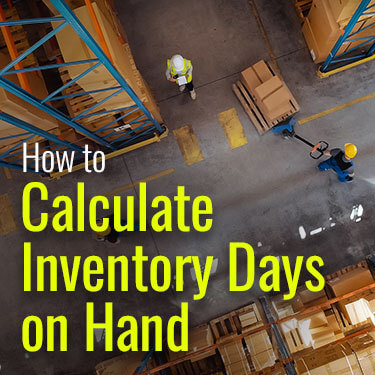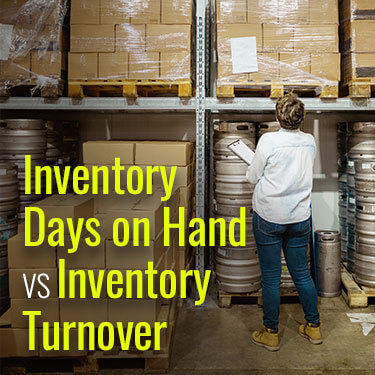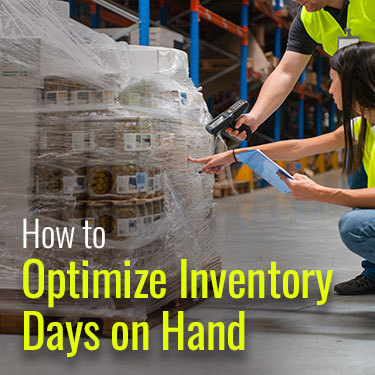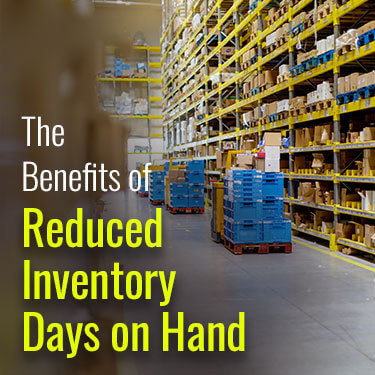
 Copy URL to Clipboard
Copy URL to Clipboard
Learning how to calculate inventory days on hand is critical to the success of any business. The ability to determine the strengths and weaknesses of your existing inventory management process is critical to the survival of your business. To implement potential strategies, you must understand how to calculate inventory days on hand.
Inventory DOH is essential for understanding and predicting market shifts, inventory effectiveness, and storage costs. Learning how to calculate inventory days on hand is done by finding your average inventory, the cost of goods sold, and the total length of time. Working with a trusted 3PL will set you up for success.
The following walkthrough will equip you with a better understanding of inventory DOH.
Table of Contents
Inventory DOH is a method of calculating the number of days it takes to sell through their amount of inventory. This is also a pure measurement of total inventory levels in a balance sheet. Days of inventory provide you with an analysis of money spent on acquisition versus the time inventory remains in stock.
Essentially, Inventory DOH is nothing more than a ratio. This figure measures the amount of time a company spends to sell its average balance of active inventory. Inventory DOH serves as an estimated number of times when an active average of the stock remains available.
Ultimately, inventory DOH tells you the number of days your product is in stock. Also, the calculation lends insight to how long your capital remains tied up to the inventory itself.
Understanding Inventory DOH is important, no matter what type of business you’re a part of. The attraction of clients both domestically and globally can shift daily. Understanding how to predict demand versus inventory is crucial to the success of any business.
A wide variety of changes can influence demand, such as holidays and trends. Sometimes, things fall in and out of popularity, or the need for certain items shifts radically. Dramatic changes can prove challenging to get an accurate projection of consumer demand versus product availability.
A business cannot adequately keep an inventory balance to meet the demand without knowing its sell-through margins. Below are three points to consider when determining how vital inventory DOH is daily.
When considering exactly why calculating DOH is important to any business including eCommerce, there are some key aspects to evaluate. There are three categories surrounding the success or failure of a business's inventory.
Inventory effectiveness, storage costs, and calculating pros and cons are important aspects of evaluation in regard to calculating inventory DOH. The three topics discussed below will help shape your calculations and their overall effectiveness as it pertains to your business.
The effectiveness of your inventory is crucial to the success of the business. As such, you need to determine the average number of days your business needs to hold onto its inventory before reselling it.
Having an explicit working knowledge of well-planned inventory management should not keep money tied up in stagnant inventory. For example, the motorcycle or kitchen appliances industry inventory can sit on stock for extended periods. Whereas in the foods industry, it cannot due to its perishable nature.
Careful consideration of storage costs should always factor into any analysis. As the inventory of any business grows, so does the additional cost of storage. Another point to consider is additional upkeep costs, which calls for a greater need for a larger workforce.
Inventory represents a significant portion of a business’s functioning costs. Therefore, it is imperative to eliminate any unnecessary overstocking whenever applicable. There are distinct pros and cons to overstocking one’s inventory.
The information below outlines the examples of both pros and cons related to overstocking. Both have their benefits while at the same time they bring potential risks to the table. It is essential to carefully consider your dynamic before deciding what's best for you.
Pros: Fast fulfillment and shortage risks
Cons: Tying up capital
Consumers like it when companies can be trusted to have what they need. Always having what they are looking for in stock is a major plus. For supply to meet demand, it may be necessary for planned overstocking. However, certain cases may dictate otherwise concerning overstocking an inventory.
When looking into a day on hand inventory calculation, it is imperative to have certain information available. Details like average inventory, costs of goods, and the length of time you want to set for your calculation are essential.
These details regarding your inventory are required to calculate your inventory DOH effectively. The information above is crucial to calculating your inventory DOH in a manner that will yield the most significant outcome. The details in your average inventory, COGS, and length of time are critical to finding the DOH of your average inventory.
To calculate average inventory, we must first identify the time frame we want to calculate. In this case, we will find the average of a fiscal year (365 days). You want to add together the starting and ending inventories, then divide them by 2. This formula will net you the average inventory of the time frame selected.
For example, our starting inventory is 500,000, and our ending inventory is 1,000,000. After adding both together, we now divide the result by 2. The average inventory result is 750,000.
| Starting Inventory | Ending Inventory | Average Inventory |
| 500,000 | 1,000,000 | 750,000 |
Once you have your inventory average, you can plug it into a new formula with the cost of goods sold and move on to the next step.
Like the previous example, we will use another formula to calculate a model to find the days on hand. This formula is [(750,000 / 5,000,000 x 365 = 54.75]
First, take the average inventory of 750,000 and divide it by the COGS of 5,000,000. Then, multiply that number by the timeframe we are measuring. In this case, we are measuring a full fiscal year. We now have calculated the days on hand to be 54.75 - when rounded, this comes to 55 DOH.
| Average Inventory | COGS | Length of Time | DOH |
| 750,000 | 5,000,000 | 365 | 54.75 |

Product availability plays an essential role in any physical or online business. Fast sell-through and quick replenishment are a testament to the effectiveness of high inventory turnover calculation.
The failure to liquidate inventory can be crippling for any business. Understanding your business’s inventory turnover rate formula is critical. The ratio shows how effective your generated sales are through the available stock you have on hand.
Turning around inventory ensures that new products are consistently available. Rotating stock at a steady pace is essential to inventory turns. If supply sits for an extended time, it can be harmful to a business.
Product cancellations can occur if a company does not replenish its inventory as needed. A stagnant inventory does not encourage people to buy new things. Knowledge of inventory days on hand and its turnaround is critical to the success of any business venture.
Juggling inventory levels is tricky when trying to balance product availability and the demands of consumers. By calculating reorder points for each product, you will find the minimums required for each product type within a stored inventory.
The idea of reorder points is that the calculation will help keep the minimums in inventory accurately. The idea is to keep a minimal inventory that paces itself with the turnover rate. At the same time, minimizing the risk of a stockout and held inventory costs.

Optimizing the inventory DOH is critical to maximizing your supply flow and profit margin potential. The reduction of available inventory should be a primary focus. Lowering your inventory DOH by increasing turnaround output is the best option for improvement.
The cost or investment made by a company to carry an inventory can be very substantial. Of course, this investment depends on the company’s size. While some feel that overstocking is good for business, it is not.
Too much of the same inventory means no room for new types of stock. When there is a high demand for goods, overstocking should be considered. Otherwise, more of your business’s capital is tied and not available for other ventures.
Getting rid of excess stock will improve your inventory DOH. There are some solutions that you can put into place to deal with any excess supply:
Overstocking and product shortages are equally dire in terms of improving inventory DOH. Nothing is more frustrating to a customer than when there is no product availability. Shortage frustrations are especially true as it pertains to regular clients or customers.

The benefits of a reduced inventory DOH can be seen in many ways. Higher inventory turnover ratios are an inventory DOH measurement that suggests you sell products at peak levels. While excess inventory costs accrue, it becomes more and more expensive.
The cost of labor, management, and utilities will multiply when you begin to overstock your inventory. With both turnover and careful management of inventory DOH, profit margins will grow while investment capital remains a the highest levels.
Having an ace up your sleeve is necessary when dealing with warehouse inventory and product management. Why deal with the hassle of worrying about the backend details when R+L Global Logistics can take care of that for you. Working with a trusted 3PL like R+L Global Logistics is the best solution for any business to achieve its goals in fulfillment.
Our Warehouse Fulfillment services are the gold standard in the logistics industry. With years of experience in domestic/international storage services and management, R+L Global Logistics knows no equal in providing you with top-tier service.
It is imperative to any business that deals in perishable goods to keep a close eye on expiration dates. These dates dictate safe product storage, safety, and shipping. Adhering to these measures ensures that perishables are sold within safe use dates.
We can also help you manage your expiring products. Expiring Product Fulfillment solutions can assist you with those needs, and our knowledgeable staff can help facilitate the process.
The management of supply chain can also be cumbersome in any retail business. In today’s ever-changing market, you need the industry standard in Retail Fulfillment. Whether third-party logistics, retail fulfillment, project rollout, or remodel plans, our experts have you covered.
